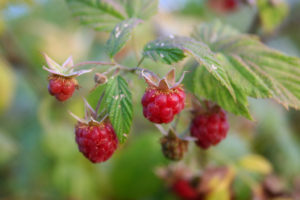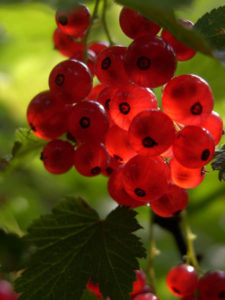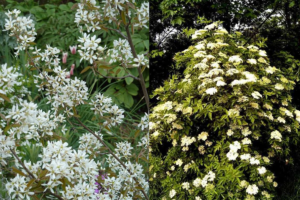I am a big fan of a landscape that is functional as well as beautiful. Functionality might mean wildlife and pollinator attraction, water absorbing (rain garden) or water conserving (xeriscaping). But it can also mean incorporating human food plants into your perennial garden. This not only provides a healthy snack, but it encourages more interaction and participation. What is the point of a beautiful landscape if you aren’t out enjoying it?
Here is a small preview of some of the plants I discuss in my Native Plant School class, now available on our YouTube channel, all about landscaping with edible plants.
If this topic fires you up, stop by our gift shop to grab a copy of Kelly Kindscher’s Edible Wild Plants of the Prairie, a wonderful plant guide and exploration of ethnobotany on the Great Plains.
Elderberry (Sambucus canadensis)

A personal favorite of mine, Elderberry is as beautiful as it is nutritious. This plant will love a low spot in the yard where water tends to collect after rains, or an area with poor drainage. It can reach 8ft tall, putting on an impressive show in late spring when covered with massive white flower clusters. Berries ripen in July, a perfect time to spend the hot afternoons in the kitchen making jams and syrups. I make a cold remedy from them that has never let me down!
Pawpaw (Asimina triloba)

Everything about pawpaw seems tropical. Surely this fruit cannot be native to hot, dry Kansas…yet it is! It is an easy growing plant that can grow in full sun or partial shade and tolerates alkaline soil. To get a good fruit set you should plant more than one; though they have both male and female flowers on a single tree they are not self-fertile. The fruit is worth it! A custard-like texture with the flavor of bananas and mangos, it is perfect for pies and homemade ice cream.
Bee Balm (Monarda fistulosa)
If you are short on garden space and can’t add a shrub or tree, never fear. Monarda fistulosa is a wonderful edible perennial much smaller in stature than the previous options. About 3ft by 3ft when happy and mature, the leaves of this plant make excellent tea, with a flavor reminiscent of the bergamot oil used in Earl Grey. It has a long history of medicinal use by indigenous North Americans, for everything from upper respiratory problems to sore feet. The flowers are also edible and add a citrusy, spicy punch to salads.
From persimmon to chokeberry, we have so many native plants to choose from to diversify our diets and add beauty to our home landscapes. Thanks to thousands of years of culinary experimentation by the tribes and nations of North America we have a rich ethnobotanical tradition to learn from, an example of how to learn about, appreciate and interact with food and flora.





